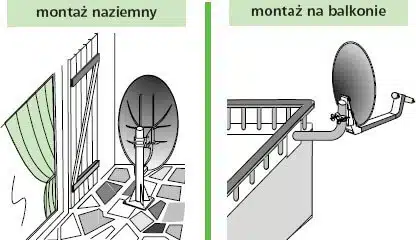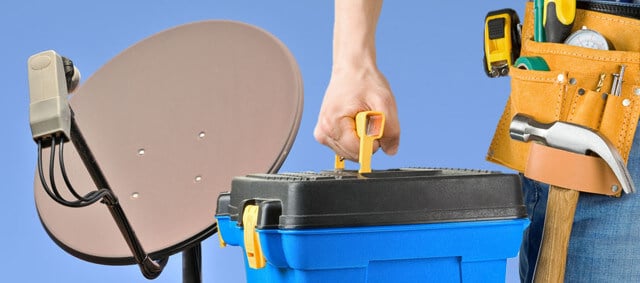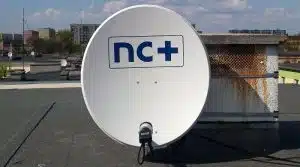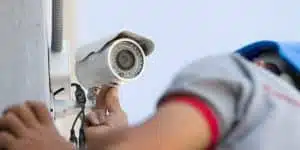It has been several years since Polish satellite platforms switched to DVB-S2 and MPEG-4 compression. It was a critical moment for all satellite TV signal recipients. This standard is more demanding in terms of signal strength and quality than the previously used DVB-S standard for SD channels, but it provides the possibility of placing a larger number of channels and/or improving the quality of currently transmitted ones.
All Polish HD channels are already broadcast in DVB-S2 standard. Probably many people have noticed that in worse weather conditions, rain or strong clouds, it is the HD channels that are more susceptible to reception problems than SD used to be. This is due to a simple reason. The most commonly used DVB for SD channels – DVB-S with FEC 5/6 – needed at least 6 dB (signal to noise ratio), whereas for DVB-S2 with 8PSK modulation and FEC 3/4 (such parameters are used in Poland nowadays) the signal needed SNR at 7.91 dB. And these are the conditions of the so-called “the”. labs. On the other hand, DVB-S with SR 27500 and FEC 5/6 on one transponder was ok. 42.24 Mbit/s bit rate, and in DVB-S2 with 8PSK modulation, SR 27500 and FEC 3/4 it is approx. 61.27 Mbit/s – The gain from each switched transponder was slightly over 19 Mbps. That’s a lot.
What can a regular user do to avoid getting tired of receiving?
To begin with, if the antenna installation is made properly, with quality components, the antenna is properly set, and it is not too small, the problems should not occur in general – except for exceptionally intensive weather conditions. It may happen that the signal is “lost” from one or two frequencies (there are stronger and weaker transponders on the same satellite), but there is not much you can do about it.
A bigger antenna always helps to keep the signal longer, but there can be some precipitation that will cut off the signal even with a 180 cm antenna. However, the general rule is that with gradually worsening atmospheric conditions the signal will first disappear on e.g. 60 cm antenna, then on 80 cm, then on 120 cm, etc. Only, of course, at some point it no longer makes sense to mount a giant antenna to receive only the basic channels.
In England it is assumed that for proper reception of channels in DVB-S2 (HD/SD) an antenna with a diameter in the range of 80-90 cmis sufficient. It is also possible in smaller installations, but we will lose stability of reception and such installation will be more susceptible to changeable weather conditions.
But that’s not all. Another important criterion is the placement of the antenna. And that requires precision. We can assure readers that we are confident that anyone can set up a satellite dish. But do it right – only people who have the knowledge, equipment and qualifications to do it. Of course, someone might accidentally get the perfect setup, but… someone wins the Lotto, too.
Precise antenna alignment without a solid measurement device (not simple diode or readout indicators, but meters showing measurements in dB) is extremely difficult. Relying on bar information on tuners as a percentage can be unreliable.
Even with a 180 cm antenna, if you don’t set it up precisely, the performance may be worse than even with a 60 cm antenna. The same is true for every other dimension of the canopy. And it is often a fight for tenths of a dB. While it may seem insignificant in good weather, when the weather conditions worsen – suddenly it will turn out that this 0.1 dB caused us to watch TV for one minute less than if it was this one tenth of a dB.
Another problem with the antenna installation issue is. precision. When installing and setting up a satellite dish, details are important. The most common mistake is lack of adjustment of the LNB’s twisting angle – in the LNB’s bracket it can be rotated, and if someone thinks that proper installation is just “cable down”, he is in a terrible mistake that costs quite a lot of losses.
On the 90 cm dish a single LNB without twist-off set for tp. 112 Cyfrowy Polsat on 13°E at 10.758 GHz, pol. V, SR: 27500, FEC: 3/4 (DVB-S2/8PSK) produced a signal with an MER of 14.3 dB, and all we had to do was improve the torsion and we got the following result on the Vector Neon S2 meter 15.2 dB (it should be noted at the outset that the antenna itself was very precisely positioned, and the result was obtained by the editors in not the best weather conditions).
Here, unfortunately, without a decent measuring device we cannot do much. Not every receiver will show this difference in the signal bars. And it may make it seem that the antenna is set up perfectly, while you can still do better, to still gain a reserve for worse conditions. That’s why you should consider bringing in a professional installer who, with their knowledge and equipment, will be able to do it as precisely as possible.
Another ignored element that may cause losses is poor placement of “F” connectors on the antenna cable and generally insufficiently stable mounting. The country is experiencing more serious wind gusts as well as heavier downpours. Inadequate protection of the “F” connectors will lead to a risk of moisture penetration and short-circuit, and failure to take care during installation will, in the short run, cause vibrations of the dish, making reception difficult in stronger winds, and in the long run will probably cause the dish to shift.
As in every area of life, price differences between products are not due to anything. Of course, there are pathological situations when products are more expensive just because they are branded, but it is worth asking the dealer when buying components for the installation to advise on the choice of components. A low-quality mirror of a steel antenna dish will probably be poorly protected and corrode, lowering signal quality. A poor quality LNB may not provide as good a signal as a higher-end device (sometimes you hit a good batch, sometimes a poor one), and a poor, cheap antenna cable will introduce additional losses into the installation, taking away valuable dB.
Conclusions:
1) For more reliable reception, if you have an antenna below 80 cm, consider replacing it with a slightly larger one.
The antenna, regardless of size, needs precise alignment.
3. precision during assembly and set-up is critical to the final result.
4. we buy equipment not the cheapest, but reliable and proven.
When you get these four elements together and do the installation correctly, there is no way it will fail.




